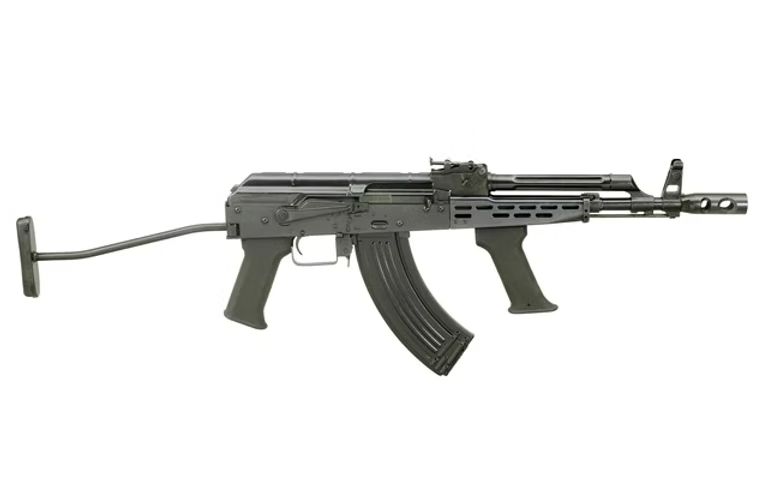Hungarian AMD-65: The Warsaw Pact’s Assault Rifle Experiment
- Владислав Шелковенко
- Jul 30
- 3 min read
Among the many Kalashnikov derivatives produced during the Cold War, the Hungarian AMD-65 stands out as one of the most distinctive and unconventional. Developed as a compact, modernized assault rifle for Hungarian forces, the AMD-65 reflected both the tactical needs of a small Central European nation and the broader design trends within the Warsaw Pact. This article explores the origins, design features, tactical roles, and operational use of the AMD-65, particularly in local and asymmetrical conflicts.
Design Origins and Motivation
The AMD-65 (Automata Módosított Deszantfegyver 1965) was introduced by Hungary in the mid-1960s. It was based on the Soviet AKM rifle but tailored to meet Hungary’s specific military and logistical needs. Hungarian engineers aimed to create a more compact weapon suitable for mechanized infantry, paratroopers, and vehicle crews — roles where a standard AKM could be cumbersome.
Unlike many Warsaw Pact countries that produced near-identical copies of the Soviet AKM, Hungary took a more innovative approach. While it retained the same 7.62×39mm cartridge and Kalashnikov operating system, the AMD-65 introduced several unique features that made it instantly recognizable.

Distinctive Design Features
The AMD-65’s most noticeable feature is its short 12.6-inch (approx. 320 mm) barrel, significantly shorter than the standard AKM barrel. To compensate for reduced accuracy and muzzle blast, it was fitted with a large, specially designed muzzle brake. This brake helped manage recoil and reduced flash, making the weapon more controllable during rapid fire.
The rifle also featured a forward vertical foregrip — an unusual addition for the time — which gave soldiers greater control during automatic fire, especially given the weapon’s compact size. This was particularly useful in close-quarters combat and urban engagements.
Another key modification was the use of a side-folding tubular stock. Made from stamped steel, it was durable yet lightweight, ideal for paratroopers or mechanized units who needed a rifle that could be stored compactly and deployed quickly.
The AMD-65 retained most of the AKM’s internal mechanics, ensuring compatibility with standard 7.62×39mm magazines and parts, but visually and tactically, it was a departure from the Soviet standard.

Tactical Role and Performance
The AMD-65 was designed with mobility in mind. Its short length and folding stock made it ideal for troops operating in and around armored vehicles, where space was limited. It was also issued to airborne and special units who valued its lightweight design.
However, the shorter barrel came at a cost: decreased effective range and reduced accuracy at distances beyond 300 meters. While this tradeoff was acceptable in urban or close-quarters combat, it made the AMD-65 less suitable for open terrain engagements.
The weapon’s forward grip helped stabilize rapid fire but was sometimes criticized for its awkward position and limited durability. Nevertheless, Hungarian troops generally found the rifle effective and well-suited to their operational environment.

Deployment and Global Use
The AMD-65 became standard issue in the Hungarian People's Army and remained in service for decades. It was also used by Hungarian police and paramilitary forces. During the Cold War, Hungary exported the AMD-65 to several allied nations and revolutionary movements, particularly in Africa and the Middle East.
Following the collapse of the Eastern Bloc, large stockpiles of AMD-65 rifles were sold or distributed globally. They appeared in a variety of conflicts, from the Yugoslav wars to Middle Eastern insurgencies, often in the hands of non-state actors and militias. The rifle’s compact size and familiarity among former Warsaw Pact soldiers made it a favored choice in close-range engagements.
In recent years, surplus AMD-65s have also entered civilian markets in the U.S. and Europe, often in semi-automatic configuration. Collectors and shooting enthusiasts appreciate their Cold War heritage, unique appearance, and reliability.

Legacy and Assessment
The AMD-65 is often seen as a bold experiment within the otherwise standardized Warsaw Pact armament system. While it never achieved the iconic status of the AK-47 or AKM, it demonstrated that smaller nations could innovate within the Kalashnikov platform to suit their own tactical requirements.
Its strengths — portability, controllability, and compatibility — made it an effective tool for specific roles, even if its shorter range limited its broader utility. As a result, the AMD-65 occupies a unique niche in the history of Cold War small arms: part Kalashnikov, part Hungarian innovation.

Conclusion
The AMD-65 reflects a distinct chapter in Cold War firearms development — one where national needs met ideological standardization. With its compact design and battlefield versatility, it served Hungary well and found extended life far beyond its original borders. Today, it stands as a testament to how even within the rigid structures of the Warsaw Pact, creativity and adaptation could thrive.



Comments